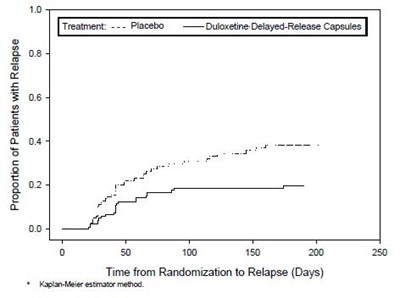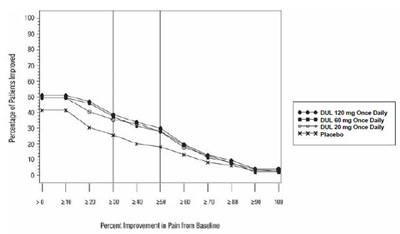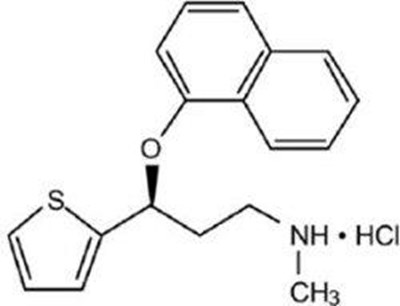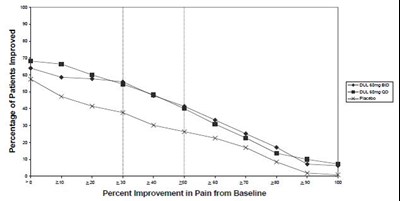Product Images Duloxetine
View Photos of Packaging, Labels & Appearance
Product Label Images
The following 19 images provide visual information about the product associated with Duloxetine NDC 0228-2890 by Actavis Pharma, Inc., such as packaging, labeling, and the appearance of the drug itself. This resource could be helpful for medical professionals, pharmacists, and patients seeking to verify medication information and ensure they have the correct product.
image 11

The text is presenting a graph showing the percentage of patients who improved while taking Duloxetine Delayed-Release 60/120 mg Once Daily in comparison to a Placebo. Additionally, the graph also displays percent improvement in pain from baseline.*
image 12

The text depicts data related to the improvement of patients after taking Duloxetine Delayed-Release 60 mg Once daily medication. The graph shows the percentage of patients improved as well as the percentage improvement in pain from baseline. The medication seems to have a significant impact on patient improvement.*
image 13

The text provides data on the percentage of patients improved and the percent improvement in pain from baseline for two types of medication: Placebo and Duloxetine Delayed-Release 60/120 mg Once Daily. The Placebo data appears to show a 90% improvement rate, while the Duloxetine treatment has a 100% improvement rate. Additionally, the text includes a chart or graph showing percent improvement in pain from baseline, as measured by "BOCF".*
image 17

This is a description of a medication named Duloxetine which comes in the form of delayed-release capsules. Each capsule contains 22.4mg of duoxetine hydrochloride which is equivalent to 20mg Duloxetine. This medication is usually prescribed with accompanying literature for dosage. The medication is stored in a tight, light-resistant container to protect it from excursions and should be kept out of the reach of children. It is manufactured by Teva Pharmaceuticals in Parsippany, 07054, and the lot/exp date is labeled below the code.*
image 18

This is a description of medication called Duloxetine in the form of delayed-release capsules. Each capsule contains 337 mg of duloxetine hydrochloride, which is equivalent to 30 mg of duloxetine. The medication guide available at www.tevausa.com/Medguides should be given to each patient along with the medication. The usual dosage is specified in the accompanying literature. The medication must be stored at 25°C (77°F) with excursions permitted to 15°C to 30°C (59°F to 86°F). The medication should be dispensed in a light-resistant container as specified in the USP, and kept out of children's reach. The manufacturer is Teva Pharmaceuticals located in Parsippany, NJ. The other details include NDC code, quantity, and LOT/EXP. No description is available for the Serialization Coding Area.*
image 19

NDC 0228-2892.03 is a medication called Duloxetine Delayed-Release Capsules, which contain 67.3 mg of duioxetine hydrochloride. Each capsule is equivalent to 60mg of duloxetine. The usual dosage for the medication is mentioned in accompanying literature. The pharmacist is required to dispense a medication guide to each patient. The medication should be stored at 25°C (77°F), with excursions allowed to 15°-30°C (59°- 86°F). The medication should be kept in a tight, light-resistant container defined in the USP, and kept out of reach from the children. Teva Pharmaceuticals manufactures the medication. The Lot/Exp date is also mentioned. Print Medication Guides can be obtained from the website.*
image 5

This is a chart displaying the proportion of patients who had a relapse over time. The chart includes data from patients who received a placebo, duloxetine, and riluzole. The X-axis represents time in days from randomization to relapse and the Y-axis represents the percentage of patients who experienced a relapse.*
image 6

This appears to be a chart depicting the proportion of patients who experience a relapse over time while taking the medication Duloxetine Delayed-Release Capsules compared to a placebo. The chart shows the percentage of patients who experience a relapse over time from randomization in days. The data is broken down into intervals of 10 days, and it seems that the Duloxetine group had lower rates of relapse compared to the placebo group. The method used to obtain the data is not clear from this text.*
image 7

This is a data visualization that displays the percentage of patients who have shown improvement in pain levels compared to their baseline. There is no additional context or information provided.*
image 9

This appears to be a chart or graph showing the percentage of patients who experience improvement in pain levels. It includes three different treatments: one with 60mg of a drug twice daily, one with 60mg of the drug once daily, and one with a placebo. The chart also shows the percentage improvement in pain from the baseline measurement for each treatment.*
* The product label images have been analyzed using a combination of traditional computing and machine learning techniques. It should be noted that the descriptions provided may not be entirely accurate as they are experimental in nature. Use the information in this page at your own discretion and risk.








